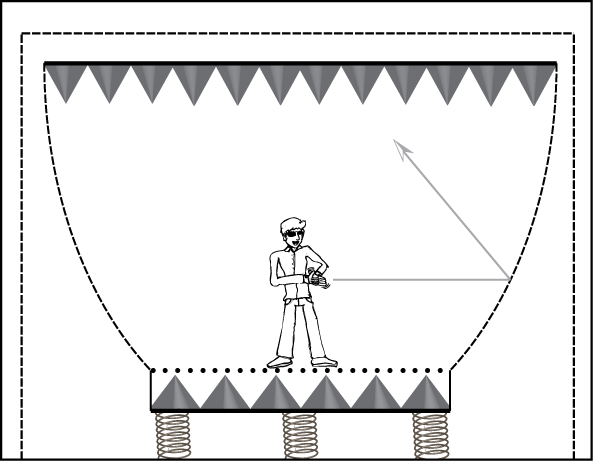Architects like to sketch out concepts. A good example is The Mix House, a home where the surrounding ambient sounds are mixed by the occupants to form a tuned interior soundscape. Inspired by this, I thought I’d sketch out an idea I have been mulling over for a clear anechoic chamber.

The idea is to take the extreme sensory experience of an anechoic chamber with its claustrophobic silence, and take it to a very busy place like a city square or shopping centre. Plonk the chamber right into the middle so you can watch the crowds passing by while experiencing the silence. Aurally it would be odd like a normal anechoic chamber, but being able to see outside would be less oppressive.
How to make one
The construction needed to make a very quiet space is relatively straightforward because it is just an extension of how sound is normally controlled in buildings. Thick glass walls with very large air gaps would be needed to block the sound passing through the walls. Like a concert hall or recording studio it would need to be mounted on springs, so it would be isolated from vibration travelling through the ground.
The more tricky bit is getting the sound absorbed by the clear walls. The completely “dead” sound this creates is an important attribute of an anechoic chamber. Normal acoustic absorbers are not transparent, however, in recent years clear absorbers have become increasingly popular. (They’re a bit like the perforated bags that fresh bread used to be sold in.) These absorbers aren’t as effective as conventional opaque designs, which is why the walls of my concept are curved like a goldfish bowl. The idea is that any remaining reflections are directed upwards away from the visitor to be absorbed by more conventional absorbing wedges in the ceiling.
Now all I need to do is convince someone to give me a lot of money to try and build one.
0 responses to “A clear anechoic chamber”
Let me know when you’ve got the funding, I’ll bring my tools , while clearsorber has many forms, but AFAIK they’re all a bit too band specific for the task, but i like the curved wall idea…. although i assume the wall geometry shown is more indicative of the idea than the actual proposed form… i’d have intuitively expected a shallower start to the curve moving out from the “flat” absorption , with some absorption lining the interface between wall and “floor” just a partial way up the lower section of wall. Love the only slightly harebrained idea , keep em coming 😉
Great stuff guys. 🙂
Hi Trevor,
I have built several cinemas using pod like shapes. Absorption panels up to dado level (1200mm) then, depending on the severity of the curve in the wall, install extrusion track system panels build on to plywood that curve into the ceiling. Here, the sound is caught by a ceiling raft. The plywood is given its shape using mf
I managed a project for Sir Ronald Cohen within his private cinema room and these panels were stepped every 1500mm to the front of the Auditoria to allow LED to be inserted into them.
I have always like the concept of this. I first come across this in Paris. The design of the road walls are curved at the top and this encourages the sound to be bounced back into the road, reducing the noise pollution.
Let me know if we can assist you in any way. This is not punt, im not fishing for work, it would be an honour.
Many thanks,
Gary
I remember when we got toured around the Salford facilities before coming to university they mentioned something about a totally transparent studio for the BBC, so that people could look at the people on the radio whilst not interfering. The guide seemed to think it was a great and interesting thing but it was probably far from anechoic and actually quite boring. Do you know anything about that?
this idea and this blog is so rad! Stumbling across it made my day!
couldn’t you evacuate the space between the transparent walls to a very low pressure? You could reduce the size of the gap needed to very little, I would think. Maybe this is what you mean already, and even with what is technically called a kinda-almost-well-I-really-tried vacuum like one finds in reality still transmits too much sound. As you can tell I am an ignorant wanderer in from the wilds of the internet, not someone who belongs here. I love the idea, though.
Maintaining a vacuum might be a problem, but in principle it would reduce sound transmission
One possibility is to create an ellipsoid with the listener/sound source at one focal point and a lump of absorption at the other focal point.